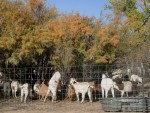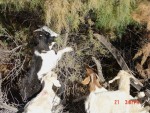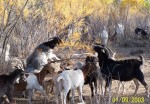Jornada scientists use goats to control salt cedar in New Mexico
Scientists at the Jornada LTER recently turned to an age-old, but almost forgotten solution to the salt cedar problem in New Mexico: goats. In a study to determine the effectiveness of goat browsing for controlling salt cedar, the scientists used 400-650 goats to browse more than 20 experimental plots for 1-2 days each during fall 2003 and 2004.
Salt cedar or tamarisk (mainly Tamarix ramosissima, though several species and hybrids occur in the southwest) is an introduced invasive riparian tree infesting more than one million acres in New Mexico. Salt cedar can increase fire danger and flooding, decrease water quantity and quality, increase soil salinity, replace native species, degrade wildlife habitat, and limit human use of riparian areas. Damage from salt cedar is projected to cost $2.9 billion in this area over the next 10 years.
Fire, flooding, herbicides, manual or mechanical removal, and biological control methods have all been used to control salt cedar. But although goats have been effective in controlling weeds and reducing woody biomass that fuel fires in the western USA, they have never been tried on salt cedar.
The study plots were located in salt cedar stands near San Acacia and San Marcial along New Mexico’s Rio Grande river valley. Western Weed Eaters, professional goat herders with extensive commercial experience in using goats for weed control and land restoration, provided and managed the goats for the study.
The goats browsed the salt cedar aggressively and gained weight during the study. They damaged nearly all the salt cedar plants in the browsed areas and removed significant amounts of biomass. In mixed vegetation, small salt cedar plants were browsed down to the ground and the width of larger plants decreased by about 34 percent. However, salt cedar resprouts strongly and it may take up to five years of browsing to exhaust root reserves and kill salt cedar plants. Most plants killed in the first two years of browsing were damaged by goats breaking branches and stripping bark. In areas where salt cedar was removed mechanically and allowed to regrow for four years, goats were particularly effective, reducing the density of resprouts by more than 50 percent.
Goat browsing was less effective in dense stands of large salt cedar with stems more than 6 cm in diameter. However, the goats also browsed the dense wall of vegetation that grew at the edges of salt cedar areas, improving access and reducing the time and cost of salt cedar removal by mechanical or manual methods. The goats also ate much of the salty layer of shed leaves or “duff” normally found under dense salt cedar, which may reduce soil salinity and improve prospects for restoration of native plants.
The goats’ long-term impact on plant species composition is not clear since they ate both undesirable weeds and desirable species. Their browsing had different effects on individual plant species, although most of the vegetation recovered during the following growing season. For example, although goats browsed grama grasses and reduced grass cover immediately after browsing, grass growth was more than twice as great in browsed areas as in unbrowsed areas after a year of regrowth.
However, after two years of browsing the goats removed nearly all of the biotic soil crust, and it is not clear how quickly the crust will recover once the browsing ends or if the bare soil will be covered with grasses and other small plants. Still, careful management of the timing and intensity of goat browsing can reduce damage to desirable species such as cottonwoods. The use of goats for salt cedar control must be adjusted to each place and time. Clearly, success depends upon the knowledge and judgment of the goat herder.
Sandy Tartowski
Jornada Experimental Range LTER

 Enlarge this image
Enlarge this image


